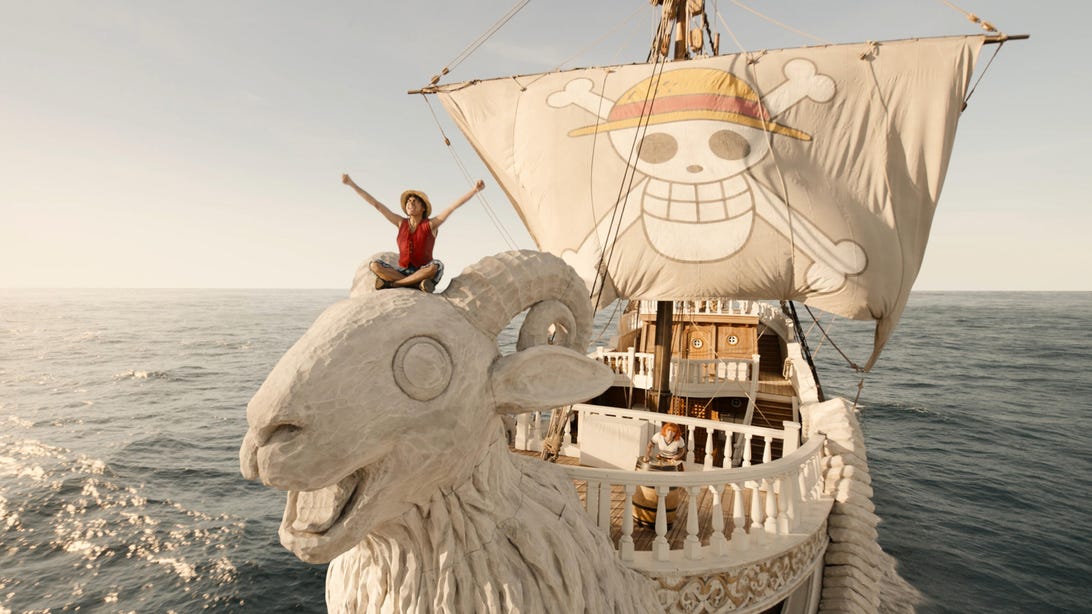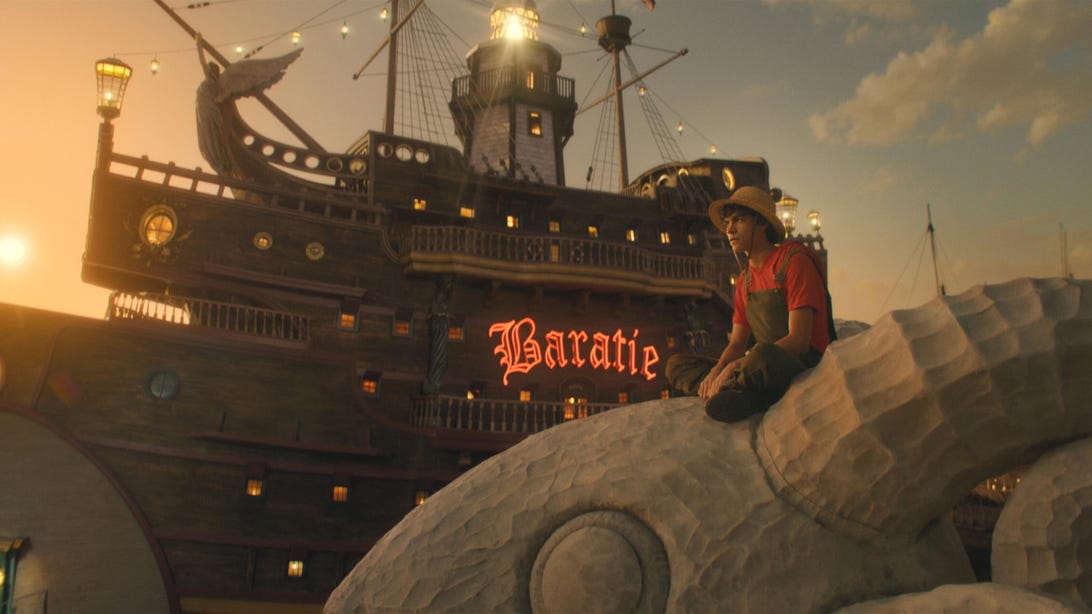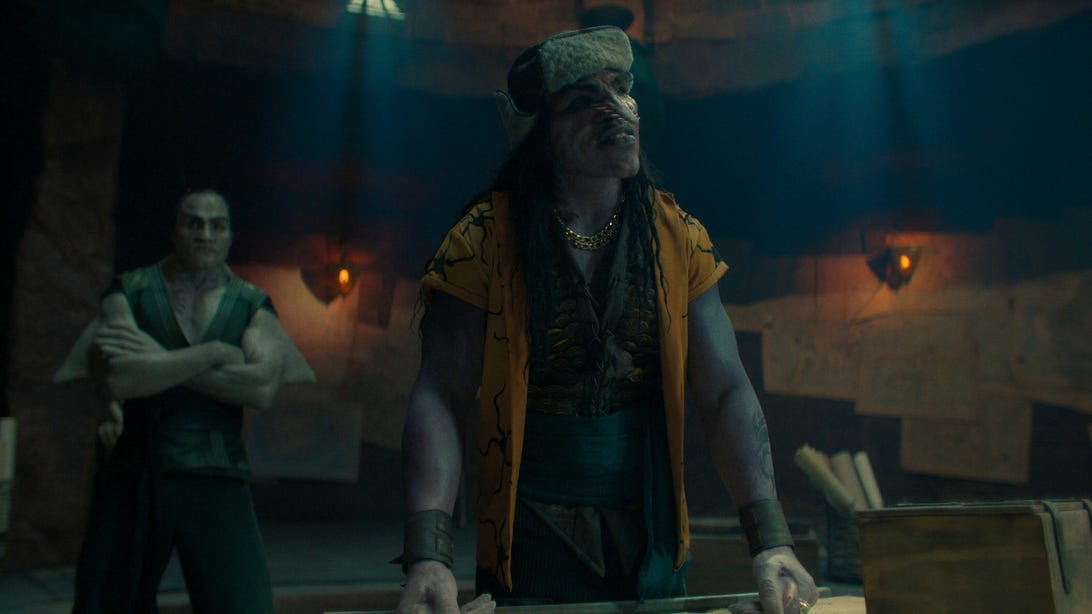Join or Sign In
Sign in to customize your TV listings
By joining TV Guide, you agree to our Terms of Use and acknowledge the data practices in our Privacy Policy.
Netflix's Live-Action One Piece Production Designer Breaks Down 5 Epic Sets, From Baratie to Arlong Park
You'll never guess what the kitchen in Kaya's mansion used to be
Production designer Richard Bridgland knew that creating sets for Netflix's One Piece would be no small task. "Looking at the manga, what struck me first was the sheer scale of the world," he told TV Guide. Bridgland dove into the series written and illustrated by Eiichiro Oda — which was the source material for the anime of the same name in 1999, and decades later would become the source material for Netflix's live-action show. "I wasn't wrong with that initial impression. It really was like designing four separate feature films for every two episodes because we were always in a different part of the world," Bridgland said.
If you watch Netflix's One Piece — which stars Iñaki Godoy, Mackenyu, Emily Rudd, Jacob Romero Gibson, and Taz Skylar as the Straw Hats, and premiered on Aug. 31 — you'd know exactly what Bridgland was talking about. Across the eight episodes that Netflix released, which covers up to Arlong Park arc in the East Blue Saga, Godoy's Monkey D. Luffy does not stay in any one place for long. That's largely because Luffy, who dreams of becoming the king of the pirates, is assembling his crew — and the members happen to be spread far and wide across the East Blue ocean.
In the eight episodes, viewers step into Kaya's mansion in Syrup Village before boarding the fish-shaped ship that is the Baratie restaurant. We watch the fish-men play carnival games in Arlong Park, before seeing the battle between Luffy and Arlong in the saw-shark's map room. And of course, the start of One Piece wouldn't be complete without the Going Merry — the Straw Hats' very first ship as they head to the fabled Grand Line. Bridgland broke down the inspirations behind each five of these locations and discussed how their appearance reflects the characters and the plot within every arc. (Yes, we know the map room is in Arlong Park but for the purposes of this story will count it separately from the fish-men's lounging area — the production designer just had so much to say about both!)
The Best and Worst Changes From Netflix's One Piece Adaptation

Iñaki Godoy, One Piece
NetflixGetting the figurehead right was key for the Going Merry
Bridgland: The one thing that I knew at the beginning was going to be the biggest challenge to design was the Going Merry. As Luffy's ship, it had to be recognizable to the fans. It had to have the right spirit to it. Looking at the figurehead in the manga, it's perfect for the manga but if you brought that into the real world and created it, it would look kind of goofy. And so I needed to come up with a way of keeping the spirit of this figurehead. What I did was — as with all the sets — I thought about what the character of Luffy was. And I realized that actually all the figureheads for all the ships were the embodiment of the spirit of those characters. Garp's character is that he's fierce, he's dogged and determined, just like a bulldog. And with Luffy's character, he is indomitable, he is courageous, and he's funny and he laughs all the time. He laughs in the face of danger, and he laughs with his friends. And so it had to have that spirit. I came up with doing a real ram's head, and made it a laughing ram. But then went through lots of different versions of it. And one of the things that we wanted to get was actually that sense that it had come from the manga, so we gave it the eyes on the figurehead of the manga. And that combination of a real ram's head but laughing, and with the eyes from the manga caught the right sort of a balance
In Nami's cabin, there are some really nice little details if the fans want to look. The curtain material I designed and had it specially made. It's [got] basically a tangerine pattern on it. And there's some stained glass in the window that also has tangerines and we use her character color in the cabin as well.
The kitchen in Kaya's mansion used to be something else entirely
Bridgland: Probably the set that I'm most excited for the fans to see is Kaya's mansion. In the manga, you never go into the mansion so nobody really knows what it looks like. I wanted to make sure that it was done in the One Piece spirit. I told a story about it. Not much is known about Kaya, but what we do know is that her grandparents started the shipyard. They started building ships for everybody in the East Blue so that would have been pirates, and Marines, and anybody who came to them. I figured that they would have a kind of sales room. So when you first walk into the house in the hallway, painted on all the walls [are] the ships that fans will recognize from other parts of the story that they built. And this will be the place where you say, "What kind of ship do you want? These are ones that we've built before." And to give it a real One Piece feel we carved these two wonderful penguins at the bottom of the staircase which is iconic to One Piece. And another part of the story was that when the pirates came, they might not have cash to pay for the ships. But they might have a cargo full of, for instance, porcelain plates. And so they would accept the plates as payment for the ship, and that's why the dining room is covered in porcelain plates.
There was a great location story here because we shot all of the Kaya stuff inside a mansion that had been built but abandoned, and there was nothing inside. It was all just sort of a concrete shell, so it was kind of a playground. And we couldn't find a room to put the kitchen in and the kitchen had some really important scenes. It needed some scale and I walked back around and there was an indoor swimming pool in there that was surrounded by columns. And I was walking around it and I thought, maybe we could put the kitchen in the swimming pool and it will be a split-level kitchen. I got an illustration of it done and it just made the most fantastic kitchen and also perfect for all the action that happened in there. And when you see it you would never know that that used to be an indoor swimming pool.
The One Piece gods were smiling on us.

Iñaki Godoy, One Piece
NetflixImagining a story for how Chef Zeff created Baratie
Bridgland: Baratie is one of my favorite sets in the show, it's so uniquely One Piece. It's a restaurant, it's made of ships and it's got this fish head on the front. It's that perfect blend of the 18th century pirate world, which is what I kind of based everything on — that was the foundation for the designs. What was great was that Oda gave clues as to how his settings had evolved. There's the wonderful book of Rurubu One Piece, which shows all of the settings and the inspiration for the settings. I did look up for Baratie. he had seen a picture of a restaurant in Vietnam that is a floating restaurant. I looked at that, and it got me thinking how Zeff would have come up with this restaurant.
The story I told myself is Zeff was a pirate, he now wanted to be a restaurateur. All he had was his ship. and he realized that he needed more rooms — for offices, for rooms for his staff. So he went to the local pirate scrapyard and bought a couple more pirate galleons and he stuck those on top. And then on his way out, there was a giant fish head that was there. He bought that as well. And he put the whole thing together to create Baratie. It was also a set that kept giving too. We love the exterior of it so much that we wanted to play more scenes outside so you could really see it. And that's what gave me the idea of putting the dorsal bar inside the fish mouth instead of inside the ship as we originally had. And it made just the most wonderfully unique bar. I wish there was a bar like that somewhere in the world for real.
Why Arlong Park had carnival games
Bridgland: It was really interesting with Arlong Park because in the manga, you kind of see this place and it's where they hang out, they play games, they do gambling. There was something about the quality of the characters in it all where it almost felt like they were at a kind of carnival. And you know the way a carnival can be a lot of fun, and then suddenly can turn sinister? In horror movies, they do it all the time. And Arlong was like that, where it's like, oh, it was really fun to hang out and then suddenly for Nami, he actually is a huge tyrant. The carnival thing kind of came up fairly early for me as an idea of a kind of symbol of Arlong's character.
Every single set that I made in the show had a story behind it. When you pull the world into live-action, 3D, you've got to give history to everything. Otherwise it doesn't feel real. Even if people don't understand what the history is, you have to put all that in there so that it feels like these people have lived there for a while, it came from somewhere. So the story I told with Arlong is that he raided a carnival a while back. He stole everything from the carnival, he brought it back to his base. Because in the One Piece lore, he finds this island and he suppresses the people, which is Nami's home island. And so I think that he moved into a temple there and set up his carnival so that they could party in it.
We had to find a location for this, and so I briefed in the location manager and I said, well, what we need to do is to find a huge kidney-shaped swimming pool — but it has to be in the middle of the woods and with no buildings around. And we were laughing because, who is ever going to find a location like that? Then the location manager said, but you know what, I might just have that location. And then she took me to this place that was about an hour outside of Cape Town. And we drove around the corner, and there in a clearing of the woods was this old kidney-shaped swimming pool with no buildings around and it was completely surrounded by forest. It was like, I can't believe you showed me this place that was kind of made for us.

Jandre Le Roux, McKinley Belcher III, One Piece
NetflixThe map room resembled both a prison and a library
Bridgland: The most important thing with [the map room] is it had to look like a prison because Nami is kept prisoner in there by Arlong. That's why the interior of it I built in stone, and it had all these sharks' heads sticking out. I took stuff from the manga which I kind of reused — Arlong has got these sharks on top of roofs. So I took those sharks and put them inside the thing. It's kind of this feeling that Nami's in this room, it's completely circular, there's no way she can hide. There's no corners to go and there are sharks' heads overlooking her, she's constantly being watched. But it also made for a very fantastic space for that big fight between Luffy and Arlong. it had to be very tall as well, because it's where Luffy shows off his rubber punch and brings the whole pagoda down. It couldn't just be any ordinary room.
And because Nami has been making maps for years and years, I thought also, it was something of a library. So although it was kind like a prison, it also is a library for all the maps of the East Blue that she's been making. And many classical libraries have that central circular space in the middle of them and so that also fed into that feeling of it being a prison but also a library at the same time.
The live-action adaptation of One Piece is available to stream on Netflix.
